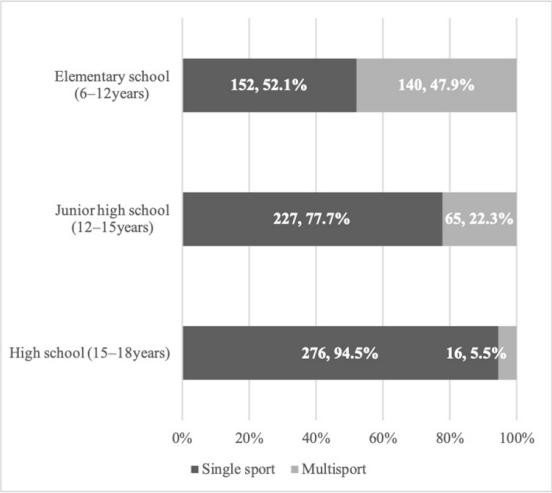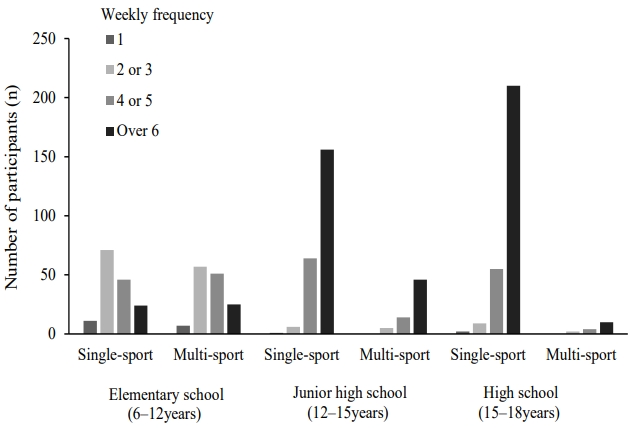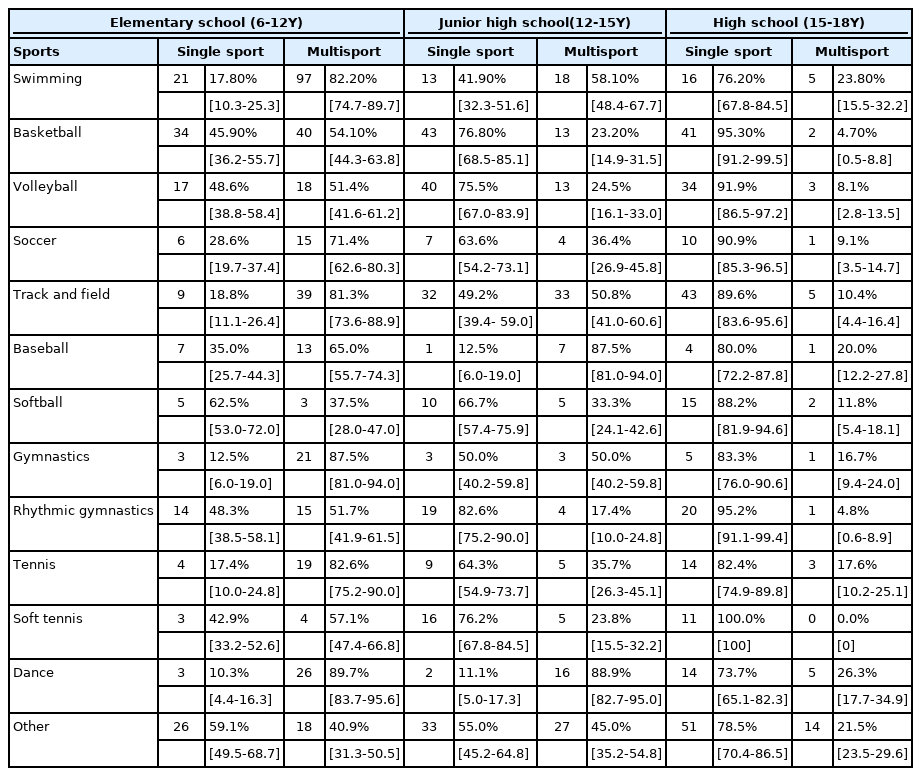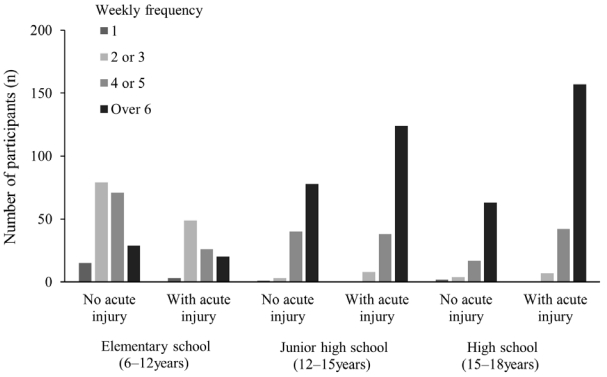Association of Sports Participation and Training Frequency with Injury in Japanese Students Majoring in Physical Education: A Retrospective Analysis
Article information
Abstract
OBJECTIVES
This study evaluated prior sports participation and training frequency during elementary to high school and their association with acute and overuse injuries in Japanese college students currently majoring in physical education.
METHODS
This retrospective study included 292 students who completed questionnaires that assessed their type of sport participation (single sport or multiple sports), training frequency (number of days per week), and injury history (acute and overuse) during the elementary, junior high, and high school periods.
RESULTS
In total, 47.9% (95% confidence interval [CI]: 38.2–57.7) of elementary school-aged athletes played multiple sports; this decreased to 22.3% (95% CI: 14.1–30.4) in junior high school and 5.5% (95% CI: 1.0–9.9) in high school. There was a significant difference in the training frequency between those who had overuse injuries and not in elementary (p < 0.05), and junior high school (p < 0.05).
CONCLUSIONS
The results of this study suggest that participating in multiple sports through junior high school may lead to improved sports levels (i.e., participation in higher levels of competition). In addition, appropriate management of training frequency may help reduce the incidence of overuse injuries.
INTRODUCTION
There has been a recent increase in the number of children who only play a single sport from an early age. Sport specialization is defined as “year-round intensive training in a single sport at the exclusion of other sports” [1]. Early sport specialization has been reported to increase the risk of burnout, as well as acute and overuse injuries. Therefore, some studies have recommended that children participate in multiple sports before adolescence and that specialization in a single sport should be avoided until after adolescence [2,3]. However, the majority of these studies have been conducted in the United States, and there is a lack of relevant data for the Japanese population.
A previous retrospective study [4] reported that 41.1% of elementary school-aged athletes engaged in multiple sports. However, the proportion of students participating in multiple sports decreased to 17.4% and 8.9% in junior high school and high school, respectively [4]. Furthermore, students who continued to participate in multiple sports in junior high school had fewer overuse injuries in both junior high school and high school [4]. Sigematsu et al. [5] conducted a study among general university students (more than half of whom had experience in city-level competitions (56%) and fewer at the prefectural (38%) or national (6%) level) and found that the proportion who played multiple sports was 23% in early elementary school, 30% in upper elementary school, 10% in junior high school, and 1% in high school. The proportion of participants with injuries significantly differed across the school years: lower elementary school (4%), upper elementary school (21%), junior high school (35%), and high school (41%) [5]. These reports indicate that Japanese students tend to begin specializing in a specific sport in junior high school (at approximately 13 years of age) and that this may be associated with subsequent acute and overuse injuries.
Based on the characteristics of sports activities in Japan, the status of single or multiple sports participation in junior high school is probably related to acute injury and overuse injury. However, the sport level of the subjects (i.e., the level of competition) in these studies was not high [4,5]. As the goal of sport specialization is to improve performance and win competitions, its association with acute and overuse injuries is more important in athletes who engage at higher competitive sport levels. Therefore, the purpose of this study was to evaluate prior sports participation and training frequency during elementary to high school and their association with subsequent acute and overuse injuries in Japanese college students currently majoring in physical education.
METHODS
Study Setting
The present study was a cross-sectional retrospective analysis of data obtained from a web-based questionnaire survey. The questionnaire was distributed to the 412 female college students (age 20-22 years) who majored in physical education in 2020 October. Respondents who agreed to participate voluntarily answered the questionnaire. A total of 352 students agreed to participate in the survey. The ethical review board of the authors’ institution approved the present study (2019-30-2), which was conducted based on the principles of the Declaration of Helsinki.
Electronic questionnaire
The questionnaire consisted of a screening question and four main questions. The following screening question was used: “Please select the sports you participated regularly in during elementary school, junior high school, and high school.” Possible responses for each school-age range included 26 different sports, as well as “other” and “no sports activity.” Participants were instructed to proceed to the main questions if they continued to engage in sports activities throughout elementary to high school. Question 1 was “Please select the frequency of participation in sports activities during elementary school, junior high school, and high school.” Possible responses included the following: “once a week,” “2 or 3 days a week,” “4 or 5 days a week,” and “over 6 days a week.” Question 2 recorded the type of sport that they engaged in the most during their school years (the results for this question are not presented in the present manuscript). Question 3 assessed their history of acute injuries that required more than 1 week of rest for recovery. Question 4 assessed their history of overuse injuries that occurred gradually and restricted their ability to continue participating in sports. In questions 3 and 4, the participants selected the injured body region from a list of 15 regions (head/face, neck, shoulder/upper arm, elbow/forearm, wrist/finger, back/chest, low back, hip/groin, thigh, knee, lower leg, ankle, foot, other, and none) for each school-age range.
Statistical Analysis
We divided the participants into two groups based on their responses to the screening question for each school-age range. Those who chose one sport were categorized into the “single-sport group,” and those who chose multiple sports were categorized into the “multi-sport group.” The proportions of single/multi-sport athletes in each sport were also calculated. Chi-square tests were used to compare the proportion of single/multi-sport athletes at each school age range and the presence of acute and overuse injuries in the single-sport group and multi-sport group. A Mann–Whitney U test was used to compare the frequency of sports participation in the presence of acute injury or overuse injury. Statistical analyses were performed using Microsoft Excel 2016 and SPSS ver19.
RESULTS
A total of 352 participants were included in the analysis; 60 participants were excluded as they either provided inappropriate answers (multiple answers or no answers) or did not continue to engage in sports activities in elementary school to high school. Therefore, 292 participants were included in the analysis. The average number of years of experience for those who continued to play sports was 10.7 years.
The proportion of single-/multi-sport athletes in each school-age group is shown in Figure 1. The percentage of elementary school-aged athletes who played multiple sports was 47.9% (95% confidence interval [CI]: 38.2–57.7); this decreased to 22.3% (95% CI: 14.1–30.4) in junior high school and 5.5% (95% CI: 1.0–9.9) in high school. There was a significant difference in the proportion of single-/multi-sport athletes among the different school-age groups (p < 0.01). The proportion of multi-sport athletes in elementary school was greater than that in junior high school (p < 0.01, φ = 0.265) and high school (p < 0.01, φ = 0.476); this proportion was also greater in junior high school than in high school (p < 0.01, φ = 0.238). No significant difference in the frequency of participation in single and multiple sports was observed (Figure 2).
The proportion of single-/multi-sport athletes in each sport are shown in Table 1. Only sports with 15 or more athletes in any one of the school-age groups are listed; sports with fewer than 15 athletes were grouped in the "other" category.
The frequency of sports participation in the presence of acute injury or overuse injury are shown in Figures 3 and 4. The means and standard deviations for the frequency of training with and without acute injury for each age group were 3.9±1.5 and 3.6±1.7 days for elementary school, 5.8±1.1 and 5.8±1.1 days for junior high school, and 6.0±1.0 and 5.7±1.3 days for high school, respectively. Means and standard deviations for the frequency of training with and without overuse injury were 4.2 ± 1.5 and 3.6 ± 1.6 days for elementary school, 6.0 ± 1.0 and 5.6 ± 1.2 days for middle school, and 6.0 ± 1.0 and 5.7 ± 1.4 days for high school, respectively. The prevalence of acute and overuse injuries is shown in Table 2. Significant differences in training frequency between those who had overuse injury and those who had not were found in elementary (p < 0.05), and junior high school (p < 0.05). The occurrence of acute and overuse injuries among participants who engaged in single and multiple sports is shown in Table 3. There were no significantly different among single and multiple sports group.
DISCUSSION
In the present study, we evaluated the relationships between acute/overuse injury and prior sports participation (single-or multi-sport) and training frequency (weekly days of sports participation) in Japanese college students currently majoring in physical education.
The proportion of single-/multi-sport athletes increased with age especially in junior high school in present study. This result is supported by previous studies conducted in the other countries [6,7] that documented increased sport specialization in older student age groups; however, in contrast to our findings, these studies also reported that a certain proportion of students had a low level of sport specialization at junior high school and high school age [6,7]. As a characteristic of sports participation in Japan, the proportion of single-sport athletes increased greatly in the junior high school age group; in the high school age group, most students played a single sport.
The proportion of students participating in multiple sports was 22.3% in junior high school. These values are higher than those reported by previous studies. Nagano and Oyama [4] reported rates of 17.4% in junior high schools. Shigematsu et al. [5] reported even lower rates of 10% in junior high schools. This discrepancy may be attributed to the fact that the participants in the present study were majoring in physical education; therefore, they were more likely to have been engaged in more competitive (higher) levels of play. This suggests that participation in multiple sports may lead to an improvement in the sports level. This may be related to the fact that many professional and Olympic athletes have previously participated in multiple sports [8-12].
Our results indicated that the number of overuse injuries increased with the amount of training. This was particularly evident for overuse injuries especially in elementary and high school age groups. This result is consistent with previous studies [4,5,13,14]. Therefore, the training frequency should be carefully managed to reduce the risk of overuse injuries [6,8,13].
There was no significant difference in the occurrence of acute and overuse injuries between students who participated in single and multiple sports. This was unexpected, as sport specialization is considered to be particularly associated with an increased risk of overuse injury. However, the prevalence of both acute and overuse injuries was higher than that in previous studies [4]. This may be due to the fact that the training frequency in single and multi-sport group was higher than that of students in previous studies [4]. Therefore, the differential effect of participating in single and multi-sport may have been masked by the overall high levels of training among students in the present study.
Our study had several limitations. First, this was a cross-sectional study that used a self-report questionnaire that required participants to recall information. Although we limited the potential effects of recall bias by restricting our study sample to college students, it is possible that they were unable to recall prior injuries; they may have also underestimated or misinterpreted responses pertaining to acute and overuse injuries. Second, we only included students who were majoring in physical education. Although they had a high level of participation in sports, it was not possible to account for their prior involvement in competitions at the city, prefecture, and national levels. Third, we did not use the definition of sport specialization described in previous studies [15]. Instead, we classified single and multiple sports according to the number of sports that the students chose to participate in within each school-age range. Therefore, it was not possible to make an accurate comparison of sports participation between Japan and other countries.
CONCLUSIONS
In this study, we evaluated the prior participation in sports activities from elementary to high school among Japanese college participants who were currently majoring in physical education. The results indicated an increase in the proportion of students who specialized in a single sport at an approximate age of 13 years during the junior high school period. Nevertheless, the proportion of students who participated in multiple sports remained relatively high. This suggests that participation in multiple sports may lead to improved sports levels. A high training frequency was also associated with the occurrence of overuse injuries; this was particularly evident in elementary and junior high school. Therefore, appropriate management of training frequency may help reduce the incidence of overuse injuries.
Acknowledgements
This work was supported by the Nikaido research grant of the Japan Women's College of Physical Education in 2020 (awarded to YN).
Notes
Conflict of Interest
The authors declare no conflict of interest.







